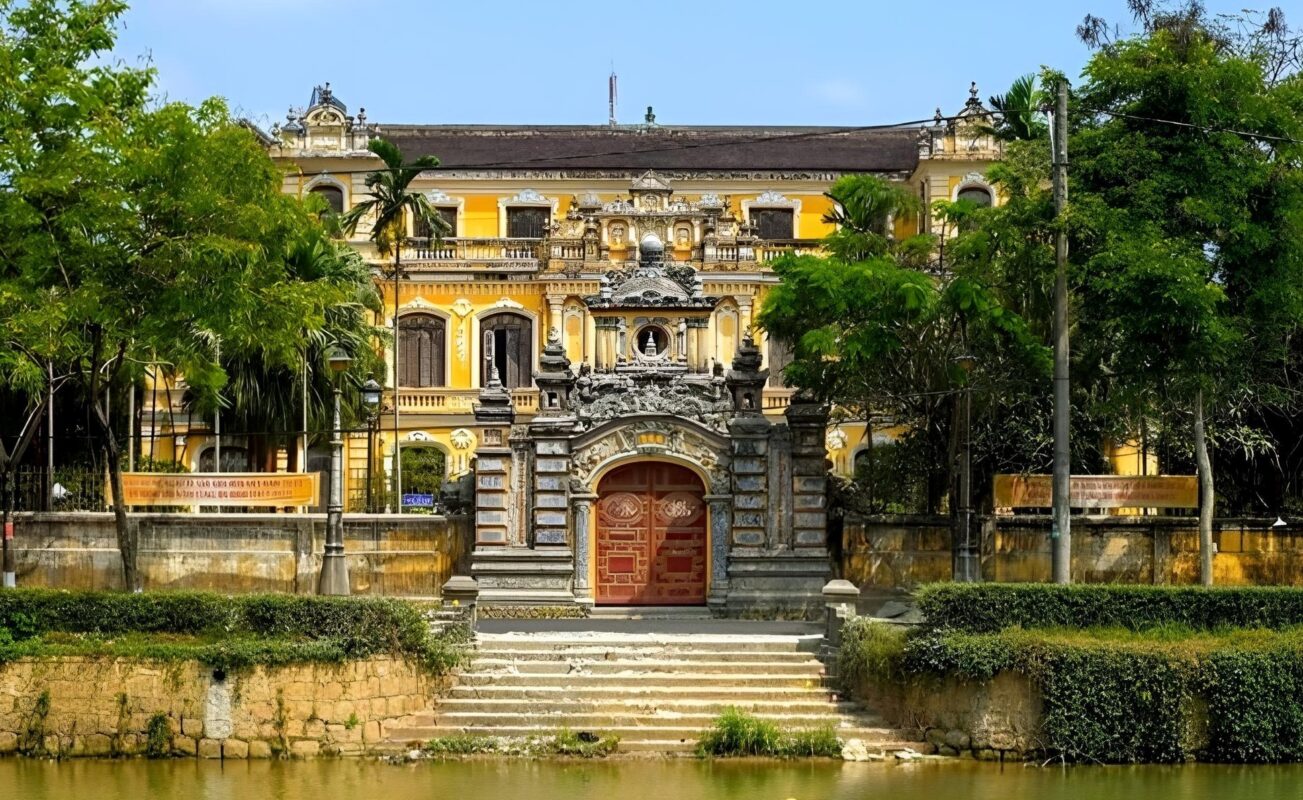An Dinh Palace in Hue Vietnam History
An Dinh Palace, located in the heart of Hue, Vietnam, is a remarkable architectural and historical site closely linked to the Nguyen Dynasty. Built in 1917 by Emperor Khai Dinh as a private residence, the palace later became the home of Emperor Bao Dai, the last emperor of Vietnam.
After the fall of the monarchy, An Dinh was abandoned for many years before being restored to its former glory. Today, it stands as a testament to Vietnam’s royal heritage and French colonial influence.
During and after a lovely stay in the ancient capital of Vietnam under the Nguyen Dynasty, you may need our services
- Hue to Da Nang Airport transfer– from 61 USD/ Sedan.
- Hue to Hoi An by car– from 65 USD/Sedan
- Hue Tombs Tour– from 46 USD/ pax/ group tour.
- Hue Imperial Citadel Walking Tour– from 27 USD/ Pax.
- Hue to Phong Nha private Car– from 95 USD/ Sedan.
- Hue city private tour– from 57 USD/ Pax.
An Dinh Palace Architectural Beauty
An Dinh Palace boasts a harmonious blend of traditional Vietnamese royal design and European-style architecture. The palace’s intricate details, exquisite sculptures, and beautifully painted walls reflect the luxurious lifestyle of the Nguyen Dynasty.
The Main Gate
The main gate of An Dinh is a striking example of early 20th-century Vietnamese architecture. The gate is adorned with elaborate motifs, including dragons and phoenixes, symbolizing power and prosperity.
Visitors can marvel at the detailed craftsmanship that showcases the grandeur of Vietnam’s last imperial era.
Trung Lap Communal House
Once inside the palace grounds, visitors encounter the Trung Lap Communal House. This octagonal structure houses a statue of Emperor Khai Dinh and reminds visitors of the Nguyen Dynasty’s deep cultural and spiritual roots.
The house is intricately decorated with traditional patterns, reflecting the emperor’s refined taste.
Khai Tuong Pavilion
The centerpiece of An Dinh Palace is the Khai Tuong Pavilion, a three-story structure that once served as the royal family’s living quarters. The pavilion’s interior is adorned with elaborate frescoes depicting Vietnamese mythology, royal ceremonies, and everyday life.
European influences are evident in the arched windows, decorative columns, and intricate ceiling paintings, creating a unique fusion of Eastern and Western styles.
The backyard of An Định Palace
The backyard of An Định Palace is a tranquil space that reflects both imperial grandeur and colonial-era aesthetics. Some key features include:

Lush Gardens: The backyard features beautifully landscaped gardens with tropical plants, flowering shrubs, and ancient trees that create a serene atmosphere.
Decorative Fountains: Remnants of decorative fountains and water features suggest that the backyard once had a sophisticated irrigation system, enhancing the peaceful ambiance.
Architectural Remnants: Some smaller structures and decorative elements remain in the backyard, displaying intricate carvings and European-influenced motifs.
Walkways and Open Space: There are stone pathways that allow visitors to stroll through the backyard, providing a quiet retreat from the grandeur of the palace’s main hall.
Historical Significance: The backyard may have once served as a private space for royal family members, used for leisure and relaxation away from public affairs.
How to get to An Dinh Palace?
The palace is conveniently located at 97 Phan Dinh Phung Street, Hue City, making it easily accessible from various parts of the city. Here are some ways to get there:
By Bicycle or Motorbike: Renting a bicycle or motorbike is a popular option for exploring Hue. The ride to An Dinh Palace offers scenic views of the city.
By Taxi or Grab: Visitors can book a taxi or use ride-hailing services like Grab for a quick and comfortable trip.
By Cyclo (Three-Wheeled Rickshaw): For a more traditional experience, consider hiring a cyclo, a slow but charming way to explore the city’s historical sites.
Book a private car: with an English-speaking driver: maximize your day by combining visiting An Dinh Palace with other famous attractions such as Hue Imperial Citadel, Minh Mang Tomb, Khai Dinh Tomb, The royal tomb of Tu Duc Emperor, and Thien Mu Pagoda with a friendly, experienced driver via Vietnam Student Exchange Travel.
Important Notes for Your Visit to An Dinh Palace
An Dinh Palace Hue opening hours: This Palace is open daily from 7:00 AM to 5:30 PM.
Entrance Fee: The ticket price is approximately 50,000 VND per person (subject to change).
Dress Code: As a historical site, visitors are advised to dress modestly and respectfully.
Best Time to Visit: The ideal time to visit is from March to August when the weather is pleasant and dry.
Photography: Photography is allowed, but flash photography may be restricted in certain areas.
Guided Tours: Hiring a guide can enhance your experience by providing deeper insights into the palace’s history and architecture.
An Dinh Palace is a must-visit destination for anyone exploring Hue. Its rich history, exquisite architecture, and cultural significance make it an unforgettable stop on your journey through Vietnam’s imperial past.
Famous Tourist Attractions Near An Dinh Palace
Hue is rich in historical and cultural sites, making it an ideal destination for history enthusiasts. Some must-visit attractions near An Dinh Palace include:
Imperial City of Hue: A UNESCO World Heritage Site and the former political and cultural center of the Nguyen Dynasty.
Thien Mu Pagoda: A stunning seven-story pagoda situated on the banks of the Perfume River.
Dong Ba Market: The oldest and largest market in Hue, offering local delicacies and handicrafts.
Tu Duc Tomb: One of the most poetic and well-preserved royal tombs of the Nguyen emperors.
Perfume River: A beautiful river offering scenic boat rides and breathtaking sunset views.






